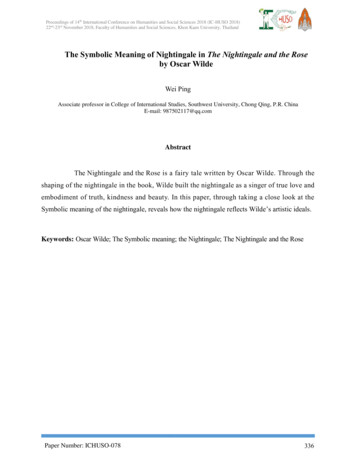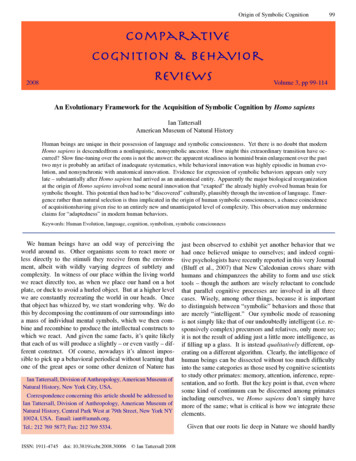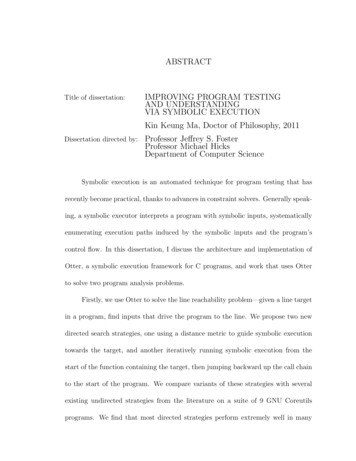
Transcription
Proceedings of 14th International Conference on Humanities and Social Sciences 2018 (IC-HUSO 2018)22nd-23rd November 2018, Faculty of Humanities and Social Sciences, Khon Kaen University, ThailandThe Symbolic Meaning of Nightingale in The Nightingale and the Roseby Oscar WildeWei PingAssociate professor in College of International Studies, Southwest University, Chong Qing, P.R. ChinaE-mail: 987502117@qq.comAbstractThe Nightingale and the Rose is a fairy tale written by Oscar Wilde. Through theshaping of the nightingale in the book, Wilde built the nightingale as a singer of true love andembodiment of truth, kindness and beauty. In this paper, through taking a close look at theSymbolic meaning of the nightingale, reveals how the nightingale reflects Wilde’s artistic ideals.Keywords: Oscar Wilde; The Symbolic meaning; the Nightingale; The Nightingale and the RosePaper Number: ICHUSO-078336
Proceedings of 14th International Conference on Humanities and Social Sciences 2018 (IC-HUSO 2018)22nd-23rd November 2018, Faculty of Humanities and Social Sciences, Khon Kaen University, ThailandI. Introduction of Oscar Wilde and The Nightingale and the RoseOscar Wilde (1854-1900), a modern British aesthetic writer, lived in the middle andlate 19th century. It was called the "end of the century" period, and was also regarded as the "goldenperiod" by the British historians. At this time, precisely after the "industrial revolution", the rapiddevelopment of industry and commerce, the material world has undergone a drastic change thathas never been seen before, and the "material supremacy" of money worship has permeated theentire society of Great Britain.In Wilde’s time, people emphasized much on reality and reason sothat they ignored love and beauty. With the thought that money is everything, people became theslave of power and money.The Nightingale and the Rose is a fairy tale written by Oscar Wilde. It was first includedin The Happy Prince and Other Tales which was published in 1888 (Holland 61-62). The fairy taletells a story about a nightingale. In order to get a red rose for the young student, the nightingaleflied here and there, asking every Rose-tree she met. And she was finally told that the Rose-treegrowing under the student’s window would give her one. So she flied to it happily, but only beingtold that there was no red rose at all because the tree’s veins had been chilled and so were its budsdestroyed by the frost. The nightingale must build it out of music by moonlight and stain it withher own heart’s blood. So at the price of her life, the nightingale succeeded getting a red rose. Whenthe student brought the red rose to the girl he fell into, the girl refused him, saying that the flowerdidn’t go with her dress and she had received some pearls and jewels from the Chamberlain’snephew. Complaining and angry, the young student threw the red rose into the street. As so, theflower built out of the nightingale’s life was finally grinded under a cartwheel and fell into thegutter. The student whom the nightingale believed a true lover returned to philosophy andmetaphysics with the thought that love is a silly thing.II. The Symbolic meaning of Nightingale in The Nightingale and the RoseThe nightingale is mainly produced in Western Europe. It is petite and exquisite, withagile movements, clear and mellow sounds, charming timbre, and more lingering in the quiet andserene moon and night, so it is called the nightingale. The nightingale is a lovely and favorableimage for the English writers. In the early period of the nineteenth century, the famous romanticpoet John Keats wrote a long poem named Ode to the Nightingale. Through the nightingale’ssinging, this poem expresses people’s longing for immortality and eternity of love. Wilde admiresJohn Keats very much and is influenced by him to some extent. Naturally, here in The Nightingaleand the Rose, Wilde adopts nightingale’s traditional artistic image as the singer of true love and theembodiment of truth, kindness and beauty.A. Singer of true loveWilde himself commented in a letter to his friend Thomas Hutchinson: “TheNightingale is the true lover, if there is one. She, at least, is Romance, and the Student and the girlare, like most of us, unworthy of Romance” (qtd. in Zhang Yunfang 43). So, for Wilde, thenightingale is the only true lover in the book who has a romantic soul, which indeed makes aremarkable contrast with the student and the girl, the representative of mankind. In this fairy tale,a principal theme that the materialistic civilization is the murder of true love and beauty is clearlydisplayed in the image of the nightingale. And Wilde, through the following aspects, successfullybuilds the image of the nightingale as a true lover.On the one hand, Wilde compares the nightingale with other creatures and the girl tohighlight the nightingale’s praise of true love. At the beginning of the story when the young studentis crying for having no red roses for his love, other creatures like the green lizard, the butterfly andPaper Number: ICHUSO-078337
Proceedings of 14th International Conference on Humanities and Social Sciences 2018 (IC-HUSO 2018)22nd-23rd November 2018, Faculty of Humanities and Social Sciences, Khon Kaen University, Thailandthe daisy are laughing at him and think him ridiculous. Only the nightingale understands him andis willing to find him a red rose at any price. So she flies here and there looking for a red rose, onlyto be told that there is no red rose unless she builds it with her music and stain it with her ownheart’s blood. Although in many people’s minds, it is unworthy to exchange a red rose with life,but to the nightingale, love is the best thing. And she is overjoyed to sing of the birth of love andpassion in the heart of a boy and a girl. Nevertheless, when the student brings the red rose to hisbeloved girl, he is relentlessly refused by the girl because she has received some pearls andjewelries from the Chamberlain’s nephew. And out of rage and hatred, the student throws the redrose onto the street like litter. Here Wilde criticizes the girl’s vanity and laments over the death ofthe nightingale. The girl is so shallow, superficial and snobbish compared with the nightingale andis in fact the representative of evil in the worldly world. The contrast between the nightingale, herfellow creatures and the girl makes the image of the nightingale more remarkable and outstanding.She is the only one that knows love and would sacrifice everything for getting it.On the other hand, Wilde describes the nightingale as a pilgrim of true love. In orderto get a red rose for the young student, the nightingale bears a great pain and eventually sacrificesher life. But why would she give up her own life for a stranger without any hesitation? Here is theanswer:“Here indeed is the true lover,” said the nightingale. “What I sing of, he suffers: whatis joy to me, to him is pain. Surely Love is a wonderful thing. It is more precious thanemerald, and dearer than fine opals. Pearls and pomegranates cannot buy it, nor is it setforth in the market-place. It may not be purchased of the merchants, nor can it be weighedout in the balance for gold” (Wilde, The Nightingale and the Rose 2).It is obvious that the nightingale regards love as something invaluable and she has arooted faith in it. Her pursuit of true love gives her a philanthropic soul so that she would sacrificeher life for other people’s happiness. Her death not only sublimates the value of her life but alsodefend the dignity of love. And in the process of her seeking for the red rose, she comes across twofailures, one is the meeting with the white rose tree, another is with the yellow rose tree. However,she never thinks of giving up. At this point, the nightingale is very different from the student whodoes nothing to fight for his dream, but cry and complain about the reality and escape into the worldof philosophy and metaphysics. Here Wilde fiercely criticizes the student’s non-doing and eulogizethe nightingale’s constant pursue of love.In fact, the nightingale’s chase for love is Wilde’s chase for art and his revolt againstthe cruel reality. In Wilde’s times, the joy and comfort brought by money and material haspenetrated people thoughts and seriously affected their values and outlook about the world. Fewpeople still keep the purity of their heart from the evil reality. As he writes in The Nightingale andthe Rose:But the winter has chilled my veins, and the frost has nipped my buds, and the stormhas broken my branches, and I shall have no roses at all this year (5).Here the red rose stands for pure love while the hostile environment stands for the cruelreality. The materialistic society has corrupted people’s faith and values. So facing with such asituation where the money is worshiped, philistinism and the hypocritical morality prevail, Wildeseeks refuge in art. He separates art from the real life, hoping to refresh the society with pure artcreation of extreme beauty. The nightingale is such a product of art. Besides, the nightingale isPaper Number: ICHUSO-078338
Proceedings of 14th International Conference on Humanities and Social Sciences 2018 (IC-HUSO 2018)22nd-23rd November 2018, Faculty of Humanities and Social Sciences, Khon Kaen University, Thailandcreated by the author’s imagination. She is an untrue, made-up image which is beyond reality andfar from life and the background is also a fabled one. All these reflect Wilde’s aesthetic idea thatart should be free of life.B. Embodiment of truth, kindness and beautyQualities like truth, kindness and beauty are the highest praise to people. Truth is to bethe authentic self and be honest and earnest to others. Kindness, according to the Collins COBUILDAdvanced Learner’s English Dictionary, is the quality of being gentle, caring and helpful. A kindperson not only gets good things done, but encourages others to do the same thing. And beauty isthe state or quality of being beautiful, both physically and mentally. And in The Nightingale andthe Rose, Wilde appeals to people to go after the truth, kindness and beauty of their heart throughthe shaping of the nightingale.In the story, Wilde first presents us an authentic and kind-hearted image of thenightingale. She is an idealist as well as a practitioner of true love. She knows what she wants andwhat she dislikes. Though being laughed at and doubted by her companions, she sticks to her dreamand faith. So when she heard the student’s weeping for having no rose to satisfy his lover, shebelieves that the student is a true lover just like herself. Partly for realizing her own dream andpartly out of sympathy and kindness, she help the student find a red rose by scarifying her life. Andthus an image of great courage, sincerity and kindness is achieved. And it is because of her possessof those qualities that she is regarded as the embodiment of beauty.But in this fairy tale, Wilde focuses on the tragic beauty of the nightingale’s death (Huand Wang 256). For most of us, death is something sad and miserable, but in Wilde’s writings,death give people a sense of beauty. Many characters in his writings have very short but splendidlife. In his eyes, the beauty of death will make a person immortal and make the value of beautyeternal. In fact, the death of the nightingale embodies Wilde’s pursuit of truth, kindness and beauty.The nightingale dies tragically but beautifully. It is a tragedy because her sacrifice isunworthy and meaningless. The student is never a true lover:“What a silly thing Love is” said the Student as he walked away. “It is not half asuseful as Logic, for it does not prove anything, and it is always telling one of things thatare not gonging to happen, and making one believes things that are not true” (Wilde, TheNightingale and the Rose 11-12).He is ungrateful while he criticizes the girl as ungrateful. Meanwhile he does not knowwhat true love is nor does he understand the nightingale. On the other hand, it is ridiculous that therose exchanged by life is defeated by jewelry. Just as the girl said, “everybody knows that jewelscost far more than flowers” (Wilde, The Nightingale and the Rose 11). Here Wilde attacks theutilitarian society.And it is beautiful because the nightingale dies nobly. The snobbish girl and thehypocritical student serve as a foil to the beauty of the nightingale. She dies for a noble course asrefreshing the degraded society. As the solitary fighter for pure art, she is beautiful in appearanceand in mind. Her death indeed makes her life respectable and immortal. Only those beautiful thingsthat are cruelly destructed can give people a visual shock and heart quake. The formal beauty andemotional shock can create eternity.As is discussed above, the nightingale is built as the embodiment of truth, kindnessand beauty which are the most precious qualities one may have. But actually, it is impossible thatsuch a perfect image exists in real life. So the nightingale is just an ideal image created by thePaper Number: ICHUSO-078339
Proceedings of 14th International Conference on Humanities and Social Sciences 2018 (IC-HUSO 2018)22nd-23rd November 2018, Faculty of Humanities and Social Sciences, Khon Kaen University, Thailandauthor’s imagination, representing an extreme beauty of art creation, and those artists who keep apure heart to art. Meanwhile truth, kindness and beauty represent pure art. Therefore, it can beconcluded that Wilde’s art creation of the nightingale is just the creation of beauty for pure art,which is the very explanation of art for art’s sake.IV. ConclusionIn Wilde’s eyes, art has its own value and life and it should not be restrained by socialreality or morality. And art creation should aim at nothing but creating beauty, meanwhile, he thinksthat art anticipates life. In the story of The Nightingale and the Rose, with the nightingale’s selflessassistance to the student and her death for getting the rose, Wilde built the nightingale as a singerof true love and embodiment of truth, kindness and beauty through contrasting the nightingale withother characters in this story. In this way, Wilde not only expresses his disgust at the dirty socialreality but also his artistic ideals. In fact, to some extent, the nightingale is on behalf of Wildehimself and the ideal artists in Wilde’s mind. The nightingale’s pursuit of true love, truth, kindnessand beauty is just Wilde’s pursuit of pure art. From this image, one can not only see the hardshipsin the course of his pursuing of pure art but also the persistence of his pursuit.Works CitedLiu, Bingshan. A Short History of English Literature. Newly Revised & Enlarged Edition.Zhengzhou: Henan People’s publishing house, 2007.Sun, Huicong. From John Keats to Oscar Wilde—Aestheticism in John Keats' Poetry and OscarWilde's Fairy Tales. Diss. Hebei Normal University, 2011.Wilde, Oscar. Preface. The Picture of Dorian Gray. By Oscar Wilde. London: WordsworthEditions limited, 1992. 3-4.Wilde, Oscar. The Decay of Lying and Other Essays. Eds. Penguin Group. London: PenguinClassics, 2010.Wilde, Oscar. The Nightingale and the Rose. Eds, Peng Ping. Beijing: China AstronauticPublishing House, 2015.Wu Gang. A Study on Oscar Wilde’s Literary Criticism. Shanghai: Shanghai Foreign LanguageEducation Press, 2009.Yang, Guishaung. Research on Appreciating of the Beauty to the Death Theme of Oscar Wilde’sFairy Tales. Diss. Guangxi Normal University, 2014.Zhang, Yunfang, “The Relationship between the Nightingale and the Student: Analyzing OscarWilde’s The Nightingale and The Rose.”, Youth Literator 4 (2009): 43-44.胡丹 [Hu Dan]、王玮[Wang Wei], �真、善、美”, �� [Li, Huiqin], �海外英语》 2(2014):169-170。孙宜学 [Sun, �上海:同济大学出版社,2009.王敏 [Wang Min], �唯美主义艺术观”,《考试周刊》 nd, ��上海:百家出版社,2001.吴其尧 [Wu, Qiyao],《唯美主义大师王尔德》。 杭州:浙江大学出版社,2006。Paper Number: ICHUSO-078340
Proceedings of 14th International Conference on Humanities and Social Sciences 2018 (IC-HUSO 2018)22nd-23rd November 2018, Faculty of Humanities and Social Sciences, Khon Kaen University, Thailand张介明 [ Zhang, J i em i ng] ,《唯美叙事:王尔德新论》。 ��澧 [Zhao Li]、徐京安[Xu, Jingan]等编, 《唯美主义》。 r Number: ICHUSO-078341
nightingale is the only true lover in the book who has a romantic soul, which indeed makes a remarkable contrast with the student and the girl, the representative of mankind. In this fairy tale, a principal theme that the materialistic civilization is the murder of true love and beauty is clearly displayed in the image of the nightingale.










